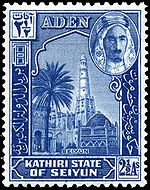Kathiri
| Kathiri State of Seiyun in Hadhramaut Template:Lang-ar al-Kathīrī | |||||||
|---|---|---|---|---|---|---|---|
| State of the Protectorate of South Arabia | |||||||
| 14th century–1967 | |||||||
|
Flag | |||||||
 Map of the Protectorate of South Arabia | |||||||
| Capital | Say'un | ||||||
| • Type | Sultanate | ||||||
| Historical era | 20th century | ||||||
• Established | 14th century | ||||||
• Disestablished | October 1967 | ||||||
| |||||||
| EB | |||||||

Kathiri (Template:Lang-ar al-Kathīrī, officially the Kathiri State of Seiyun in Hadhramaut (Arabic: السلطنة الكثيرية - سيؤن - حضرموت al-Salṭanah al-Kathīrīyah - Sayʾūn - Ḥaḍramawt) was a sultanate in the Hadhramaut region of the southern Arabian Peninsula, in what is now part of Yemen and the Dhofar region of Oman.
History
The Kathiris once ruled much of Hadhramaut but their power was truncated by the rival Qu'aitis in the 19th century. The Kathiris were eventually restricted to a small inland portion of Hadhramaut with their capital at Seiyun (Say'un).[1] The sultanate entered into treaty relations with the British in the late 19th century and became a part of the Aden Protectorate. The Kathiri State declined to join the Federation of South Arabia but remained under British protection as part of the Protectorate of South Arabia. Al Husayn ibn Ali, Kathiri sultan since 1949, was overthrown in October 1967, and the following month the former sultanate became part of newly independent South Yemen.[2]
South Yemen united with North Yemen in 1990 to become the Republic of Yemen, but local sheikhs in Yemen are reported to still wield large de facto authority.
The first Prime Minister in the history of East Timor, Mari Alkatiri (mar'ī al-Kathīrī,), is a third generation descendant of immigrants from Kathiri, part of a significant migration of Hadhramis to Southeast Asia in the 19th and 20th centuries. This is reflected in his name (Alkatiri).
The Indonesian human rights activist Munir Said Thalib is also a descendant of immigrants from Kathiri.
Rulers
| Sultans of Alkathiri | |
|---|---|
| 1395 – 1430 | Badr as-Sahab ibn al-Habrali Bu Tuwairik |
| ca. 1430 – ca. 1450 | Muhammad ibn 'Ali |
| bis ca. 1493 | Dscha'far ibn 'Abdallah |
| ca. 1516 – ca. 1565 | Badr ibn 'Abdallah |
| ca. 1565 – 17th century | unknown Sheikhs |
| 1670 – 1690 | Dscha'far ibn 'Abdallah al-Kathir |
| 1690 – 1707 | Badr ibn Dscha'far al-Kathir |
| 1707 – 1725 | 'Abdllah ibn Badr al-Kathir |
| 1725 – 1760 | 'Amr ibn Badr al-Kathir |
| 1760 – 1800 | Ahmad ibn 'Amr al-Kathir |
| 1800 – 1830 | Muhsin ibn Ahmad al-Kathir |
| 1830 – 1880 | Ghalib ibn Muhsin al-Kathir |
| 1880 – May 1929 | al-Mansur ibn Ghalib al-Kathir |
| May 1929 – 1938 | 'Ali ibn al-Mansur al-Kathir |
| 1938 – 24 April 1949 | Dscha'far ibn al-Mansur al-Kathir |
| April 1949 – 2 October 1967 | al-Husain ibn 'Ali al-Kathir |
References
- ^ Freya Stark, The Southern Gates of Arabia: A Journey in the Hadhramaut
- ^ Yitzhak Oron, Ed. Middle East Record Volume 1, 1960

